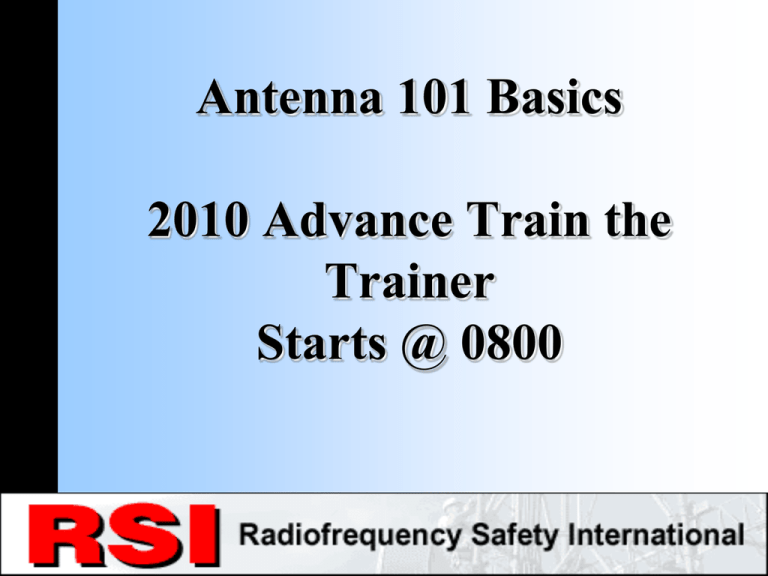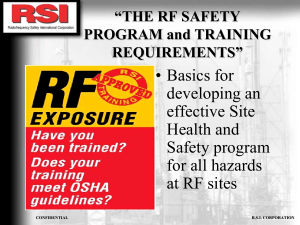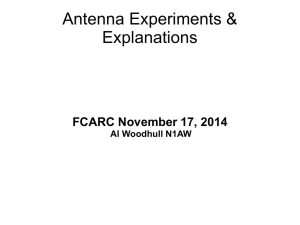2010 Edition
advertisement

Antenna 101 Basics 2010 Advance Train the Trainer Starts @ 0800 2010 Edition Confidential RSI Corporation • A fairly small amount of information and educational material can go a long way toward preventing unnecessary alarm or concern to workers and others. • Consider making some basic educational material available to anyone who wants it, not just those who need it. 20010 Edition Confidential RSI Corporation MPE Math Advance Train the Trainer 2010 Edition Confidential RSI Corporation First things first… Is RF Radiation a technical issue or a Safety issue? You can calculate the length of the snake, and how far to stay away, but if it bites you, it bites you! It is a Safety issue! 2010 Edition Confidential RSI Corporation 2002 Edition Confidential RSI Corporation More Information, We added last night after Train The Trainer! DB what is it???? Radio waves 2010 Edition Confidential RSI Corporation • STANDARDS FOR ANTENNA GAIN AND LOSS MEASUREMENTS INCLUDE: dB The universal unit of measure, named after Alexander Graham Bell. The dB is a Decibel or 1/10 of one bell. Mathematically, if can be expressed in many ways, • Watts: Output power or magnitude - using voltage, current and resistance as parameters. Volts X Amp =W • dBi: Gain with reference to the Isotropic Radiator. A very popular reference in Wi-Fi antenna systems and other applications using the 802.11 standard. • dBd: Gain reference to a dipole about 2 db • dBm The ratio of two powers referenced to 1mw (0.001Watt). 2010 Edition Confidential RSI Corporation • MPE Math Radio waves travel at the speed of light 186,000 miles per second = 300,000 kilometers per second λ TX wavelength One Hertz equals one full cycle per second 2010 Edition Confidential RSI Corporation MPE Math meters = centimeters * .01 meters = inches * .0254 meters = feet * .3048 centimeters = meters * 100 feet = meters * 3.28 inches = meters * 39.37 millimeters = meters * 1000 2010 Edition Confidential uW = mW * 1000 mW = uW * .001 EIRP = ERP x 1.64 dBi = dBd + 2 or dB + 2 W/m2 = 10(mW/cm2) mW/cm2 = W/m2 10 RSI Corporation MPE Math Wavelength from Frequency λ = wavelength f = frequency (in MHz) Problem 1: Find wavelength of 450 MHz 30000 450 = 66.66 cm = 2.19 ft Industry standard for half wave dipole in ft. λ = 492 MHz 2010 Edition RSI Corporation MPE Math Frequency from Wavelength Problem 2: Find frequency (resonance) of someone 6 ft tall. 6 ft = 182.9 cm f = 30000 = 164 MHz 182.9 Resonance λ = 164 λ = 82 MHz Isolated = 41 MHz Grounded 2010 Edition RSI Corporation Gain is real Note: See FCC OET 65 for aperture (dish) antenna equations Estimate of power from gain can be achieved by the following method: The power doubles for every 3 dB of gain 0 dB = 5 Watts 18 dB = 320 Watts 3 dB = 10 Watts 21 dB = 640 Watts 6 dB = 20 Watts 24 dB = 1280 Watts 9 dB = 40 Watts 27 dB = 2560 Watts 12 dB = 80 Watts 30 dB = 5120 Watts 15 dB = 160 Watts So 5 watts into a MW antenna with 30 dB gain would Eventually become 5120 Watts in the far field of the antenna 2010 Edition RSI Corporation Student Exercise ANTENNA GAIN 2010 Edition RSI Corporation Student Exercise Worked Example: • Gain (dB) = 7.5 +20log(6) + 20log(6.5) Gain (dB) = 7.5 +20(0.7781) + 20(0.8129) = Gain (dB) = 7.5 +15.56 + 16.25 Gain (dB) = 39.31 TO MUCH MATH, for most!!! 2010 Edition Confidential RSI Corporation Student Exercise Antenna Gain is measured in dB with reference to the Isotropic Radiator. The compounded gain of the antenna, plus the output of the transmitter is the basis for the EIRP or ERP power measurement. When using parabolic antennas with fixed dish sizes, we can calculate the gain or use a chart giving the antenna gain with respect to an Isotropic antenna. 2002 Edition Confidential RSI Corporation MPE Math Radio wave continues to increase in power density over distance with gain ant. Near field 4 Bay antenna (6 dBd gain) @ 162 MHz WX Radio & 1000 watts into the antenna = 4000 watts Radio wave decreases in power density over distance Far field Max Gain MPE Math FCC OET 65 Power Density Calculations Far field only without ground reflections S=power density in appropriate units (i.e. mW/cm2) P=power input to antenna in mW G= numeric power gain of antenna in direction of interest R (or D)= distance to the center of radiation of antenna Frii’s Equation S= PG_ 4R2 2010 Edition Confidential RSI Corporation More Field Strength • Ground reflections can double the field strength and cause a four-fold increase in power density. For low mounted antennas on rooftops reflections must be included, take 4 out of the denominator • S= PG/ R2 2010 Edition RSI Corporation From the “BMP Class” Double the field strength will cause a four-fold increase in power density (MPE). 2010 Edition From the ½ day BPM Class RSI Corporation Gain is real RF power doubles for every 3 dB of gain Every time the field strength doubles there is a four fold increase in power density (MPE) From your ½ day BMP book CONFIDENTIAL Frequency and Wavelength R.S.I. CORPORATION Frequency in kHz: (300,000) / wavelength in meters. Frequency in MHz: (300) / wavelength in meters. Frequency in MHz: (984) / wavelength in feet. Wavelength in meters: (300,000) / frequency in kHz. Wavelength in meters: (300) / frequency in MHz. Wavelength in feet: (984) / frequency in MHz. MPE Math Numeric Gain vs Logarithmic Power Gain G = 10 dBi 10 Example: dBi = dBd +2 3db = 5dBi G = 10 5 10 G = 10.5 = 3.16 Gain Unity = 2 dBi = 1.58 Gain 3 dB = 5 dBi = 3.16 Gain 12 dB = 14 dBi = 25.12 Gain 2010 Edition Confidential RSI Corporation FCC Rulemaking mW 2 /cm 100 MPE LAW Controlled 100% 5 1 20ontrolled reading is OSHA’S .2 ACTION LIMIT 0.3 3 10 OSHA ACTION LIMIT Uncontrolled 30Min TWA FM AM Radio 1 Check Both E&H < 300MHz 6 Min TWA 30 100 300 2.4 wireless Cell phones PCS 1 MW 3 10 30 100 MPE Math Power Density Calculations Far field only without ground reflections For this example, 150 MHz, 100W with 6 dB gain antenna, 20 feet (609.6 cm) away from adjacent tower. 6 dB must be changed to numerical gain 100 W = 100,000 mW Numeric Gain, G= 10^dBi = 10 .8 = 6.3 Gain 10 S = PG_ = 100,000 * 6.3 = 630,000 = 630,000 4 R2 4 R2 12.57(371612) 4,671,165 =0.135 mW/cm2 .135/ .2=67.5% The uncontrolled limit for 150 MHz is 0.2 mW/cm2, so NO PROBLEM!! 2010 Edition Confidential RSI Corporation MPE Math Power Density Calculations Far field only with ground reflections For this example, 150 MHz, 100W with 6 dB gain antenna, 20 feet (609.6 cm) away on rooftop level. Numeric Gain, G= 10^dBi = 10 .8 = 6.3 Gain 10 S = PG_ = 100,000 * 6.3 = 630,000 = 630,000 R2 R2 3.14(371612) 1,166,862 =0.54 mW/cm2 .54/ .2=270% The uncontrolled limit for 150 MHz is 0.2 mW/cm2, so it is a PROBLEM!! 2010 Edition Confidential RSI Corporation Vehicle-mounted antennas from the FCC RFR Web page May 2010 • Vehicle-mounted antennas used for wireless communications normally operate at a power level of three watts or less. These wireless antennas are typically mounted on the roof, trunk, or rear window of a car or truck. • 2010 Edition Confidential RSI Corporation • FCC Results of Studies may 2010 • Show that, in order to be exposed to RF levels that approach the safety limits it would be necessary to remain very close to a vehiclemounted wireless antenna for a significant amount of time. The metal body of the vehicle can effectively shield occupants. • Proper installation of a vehicle-mounted antenna to maximize this shielding effect is a good way to minimize exposure. The antennas should be installed either in the center of the roof or center of the trunk of a vehicle. 2010 Edition Confidential RSI Corporation Antenna 101 In order to work safely in an RF environment, it is a good idea to know what frequencies you are exposed to, as the MPE limits are based on frequency and the relationship of the wavelength to the body or its parts. 2010 Edition Confidential RSI Corporation CONFIDENTIAL R.S.I. CORPORATION The Higher the Frequency the Shorter the Wave Antennas 101 Cellular or PCS Antenna Vertical Antenna (paging, etc.) Groundplane Antenna 2010 Edition Confidential RSI Corporation Antennas 101 Cellular Antenna Microwave Parabolic Antenna General Rule: Cellular/LTE 700-900 MHz, PCS 1.9-2.4 GHz 2010 Edition Confidential RSI Corporation THE 1st PANEL ANTENNA! Antennas 101 Circularly Polarized Dipole Antenna Satellite Receive Dish Circularly Polarized BC Antenna 2010 Edition Confidential RSI Corporation CONFIDENTIAL R.S.I. CORPORATION Length of an Antenna • Quarter-wave antenna: Length in feet = 234 / frequency in MHz. • Half-wave antenna: Length in feet = 468 / frequency in MHz. Antennas 101 Antennas vary greatly: this is a rough guide to ID-ing frequencies Frequency Ranges Approx. Full Element Length (1/2 wave) Approx. Length from Center (1/4 wave) Low Band 30-54MHz 9-16.0 ft. VHF 140-174 MHz 3 ft. 1.5 ft. UHF 400-512 MHz 1 ft. 6 in. 900 MHz 6 in. 3 in. 2010 Edition Confidential 4.5-8.0 ft. RSI Corporation Antennas 101 For Verticals w/ reflectors, Note the length of the reflecting element Length (1/2 wave) Center (1/4 wave) Low Band VHF 9.0-16.0 ft. 4.5-8.0 ft. VHF 3 ft. 1.5 ft. UHF 1 ft. 6 in. 900 MHz 6 in. 3 in. 2010 Edition Confidential RSI Corporation Antennas 101 VHF ½ wave ¼ wave Low Band VHF 9.0-16.0 ft. 4.5-8.0 ft. VHF 3 ft. 1.5 ft. UHF 1 ft. 6 in. 900 MHz 6 in. 3 in. 2010 Edition Confidential RSI Corporation Antennas 101 UHF ½ wave ¼ wave Low Band VHF 9.0-16.0 ft. 4.5-8.0 ft. VHF 3 ft. 1.5 ft. UHF 1 ft. 6 in. 900 MHz 6 in. 3 in. 2010 Edition Confidential RSI Corporation Antennas 101 900 MHz ½ wave ¼ wave Low Band VHF 9.0-16.0 ft. 4.5-8.0 ft. VHF 3 ft. 1.5 ft. UHF 1 ft. 6 in. 900 MHz 6 in. 3 in. 2010 Edition Confidential RSI Corporation 30 MHz VHF (30-300 MHz) Body Wavelength 9 to 1 ½ feet! At frequencies between 30 and 300 MHz, the human body’s characteristics lend themselves to being a good 300 300MHz MHz antenna, where: The body and its parts experience maximum absorption and therefore acts like an antenna, resonating with the frequency. The Specific Absorption Rate influences the body’s ability to cool after exposure. The absorption rate decreases rapidly at frequencies above 300 MHz. CONFIDENTIAL R.S.I. CORPORATION ANTENNA 101 Antennas 101 Folded Dipole 2010 Edition Confidential RSI Corporation 2002 Edition Confidential RSI Corporation Antennas 101 Yagi Antenna 450MHz General Rule: 6MHz VHF to 2.4GHz Frequency Range 2010 Edition Confidential RSI Corporation 6-30MHz 2002 Edition Confidential RSI Corporation 2010 Edition Confidential RSI Corporation 3’long = 150MHZ 950 MHz STL 2002 Edition Confidential RSI Corporation 3 Meter wave 100MHz FM100 The loops are 1 ½ meters ½ wave antenna 100,000 watts- 8 DB =High MPE 2002 Edition Confidential RSI Corporation 2002 Edition Confidential RSI Corporation 2002 Edition Confidential RSI Corporation 2002 Edition Confidential RSI Corporation HIGH POW 4ft loops What type of antenna? UHF 51-59 to cell/phone TV UHF 51-59 to cell/phone “TV” up to 50,000 watts RF Antennas 101 The Lines in this Photo are from 50,000 watts Large BDA System Open Waveguide Leak Are there RF LEAKS in the your Equipment Rooms? AM Towers • The whole tower is the antenna (1/4 wave used widely) • Some are Non-directional • Other are using more than one tower and are directional • Some or Day time only • Other 24/7 but change power levels • Very High Current Hazard (MPE hazard lower on 500 and 1000 watt stations) with re-radiation hotspots • Must have a plan to “lock-out” when on the tower (Insulated base on most towers) AM Broadcast Three Tower Directional 5000 watt 780KHz with the city east of the towers AM Broadcast Three Tower Directional Non-directional AM Broadcast 360 D AM New Tower Added ¾ of a mile SE AM Broadcast • The FCC requires that AM Broadcast sites have Proof measurements to determine the pattern Email from a worker I work with ________ Raleigh, NC. I’ve got a question about climbing a tower that is next to four AM towers. I can’t get a straight answer from the tower owner. We need to do a work on this tower. Photos of the tower are attached. Is this tower safe to climb? or how can we check to see if the tower is safe to climb? Your advise would be appreciated. Thanks, ? 2002 Edition Confidential RSI Corporation What is wrong in this photo? Antennas 101 2010 Edition Confidential RSI Corporation That’s All Folks! Questions and Answers Take RSI’s Introduction to “RAS” Radio Antenna Systems 1-3 To learn more Any Questions? 2010 Edition Confidential RSI Corporation







